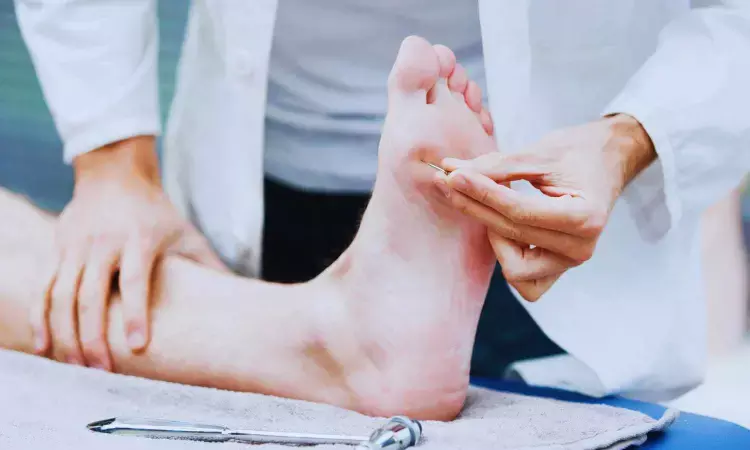- Home
- Medical news & Guidelines
- Anesthesiology
- Cardiology and CTVS
- Critical Care
- Dentistry
- Dermatology
- Diabetes and Endocrinology
- ENT
- Gastroenterology
- Medicine
- Nephrology
- Neurology
- Obstretics-Gynaecology
- Oncology
- Ophthalmology
- Orthopaedics
- Pediatrics-Neonatology
- Psychiatry
- Pulmonology
- Radiology
- Surgery
- Urology
- Laboratory Medicine
- Diet
- Nursing
- Paramedical
- Physiotherapy
- Health news
- Fact Check
- Bone Health Fact Check
- Brain Health Fact Check
- Cancer Related Fact Check
- Child Care Fact Check
- Dental and oral health fact check
- Diabetes and metabolic health fact check
- Diet and Nutrition Fact Check
- Eye and ENT Care Fact Check
- Fitness fact check
- Gut health fact check
- Heart health fact check
- Kidney health fact check
- Medical education fact check
- Men's health fact check
- Respiratory fact check
- Skin and hair care fact check
- Vaccine and Immunization fact check
- Women's health fact check
- AYUSH
- State News
- Andaman and Nicobar Islands
- Andhra Pradesh
- Arunachal Pradesh
- Assam
- Bihar
- Chandigarh
- Chattisgarh
- Dadra and Nagar Haveli
- Daman and Diu
- Delhi
- Goa
- Gujarat
- Haryana
- Himachal Pradesh
- Jammu & Kashmir
- Jharkhand
- Karnataka
- Kerala
- Ladakh
- Lakshadweep
- Madhya Pradesh
- Maharashtra
- Manipur
- Meghalaya
- Mizoram
- Nagaland
- Odisha
- Puducherry
- Punjab
- Rajasthan
- Sikkim
- Tamil Nadu
- Telangana
- Tripura
- Uttar Pradesh
- Uttrakhand
- West Bengal
- Medical Education
- Industry
New bioactive dressing promises faster diabetic wound healing, reveals research

Chronic diabetic wounds, including diabetic foot ulcers, are a significant burden for patients, as impaired blood vessel growth hinders the healing process. A recent breakthrough offers hope by combining small extracellular vesicles (sEVs) loaded with miR-221-3p and a GelMA hydrogel to target thrombospondin-1 (TSP-1), a protein that suppresses angiogenesis. This new bioactive wound dressing not only accelerates healing but also promotes blood vessel formation, offering a promising new approach to treating one of the most challenging complications of diabetes.
Diabetic wounds, particularly foot ulcers, are notorious for their slow and often incomplete healing due to reduced blood flow and endothelial cell dysfunction. One of the major contributors to this issue is thrombospondin-1 (TSP-1), which inhibits the growth of new blood vessels, a process crucial for tissue repair. Despite various existing treatments, the challenge of addressing this barrier to healing remains unmet. With the global rise in diabetes cases, new treatments targeting the underlying causes of delayed wound healing have become a critical area of research. In light of these ongoing challenges, this study explores a new approach to stimulate angiogenesis and speed up the healing process.
In a new study (DOI: 10.1093/burnst/tkaf036) published in Burns & Trauma, a team of researchers from leading Chinese institutions has unveiled a novel therapeutic solution for diabetic wound healing. The study introduces an innovative wound dressing that combines miR-221OE-sEVs—engineered extracellular vesicles that target and reduce TSP-1 levels—with a GelMA hydrogel to create a sustained-release system. This cutting-edge approach has shown to significantly enhance wound healing and blood vessel formation in diabetic mice, offering hope for more effective treatments in the future.
In their study, the researchers discovered that high glucose conditions commonly found in diabetic wounds lead to increased levels of TSP-1 in endothelial cells, impairing their ability to proliferate and migrate—key processes for angiogenesis. By utilizing miR-221-3p, a microRNA that targets and downregulates TSP-1 expression, they restored endothelial cell function. The engineered miR-221OE-sEVs were encapsulated within a GelMA hydrogel, ensuring a controlled release at the wound site, mimicking the extracellular matrix. In animal trials, this composite dressing dramatically accelerated wound healing, with a notable increase in vascularization and a 90% wound closure rate within just 12 days, compared to slower healing in control groups.
Dr. Chuan'an Shen, a key researcher in the study, shared his excitement about the potential impact of this innovation: "Our results demonstrate the power of combining advanced tissue engineering with molecular biology. By targeting TSP-1 with miR-221OE-sEVs encapsulated in GelMA, we've not only improved endothelial cell function but also ensured a sustained and localized therapeutic effect. This breakthrough could revolutionize how we approach diabetic wound care, with the potential to improve patients' quality of life significantly."
The success of this engineered hydrogel in diabetic wound healing opens up several exciting possibilities. Beyond diabetic foot ulcers, the technology could be adapted for use in treating other chronic wounds, such as those caused by vascular diseases, or even in regenerating tissues like bone and cartilage. As further research and clinical trials progress, the promise of combining miRNA-based therapies with biocompatible hydrogels could become a cornerstone in regenerative medicine, offering patients more efficient and lasting wound healing solutions.
Reference:
Yan Cong, Sheng Meng, Xiaoye Xie, Yiqi Chen, Yucong Li, Yingqian Zhou, Wandi Li, Lipeng Zhang, Guoqing Yang, Qian Wei, Chuan'an Shen, Engineered sEVs encapsulated in GelMA facilitated diabetic wound healing by promoting angiogenesis via targeting thrombospondin-1, Burns & Trauma, 2025;, tkaf036, https://doi.org/10.1093/burnst/tkaf036
Dr Kamal Kant Kohli-MBBS, DTCD- a chest specialist with more than 30 years of practice and a flair for writing clinical articles, Dr Kamal Kant Kohli joined Medical Dialogues as a Chief Editor of Medical News. Besides writing articles, as an editor, he proofreads and verifies all the medical content published on Medical Dialogues including those coming from journals, studies,medical conferences,guidelines etc. Email: drkohli@medicaldialogues.in. Contact no. 011-43720751


